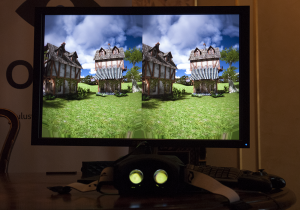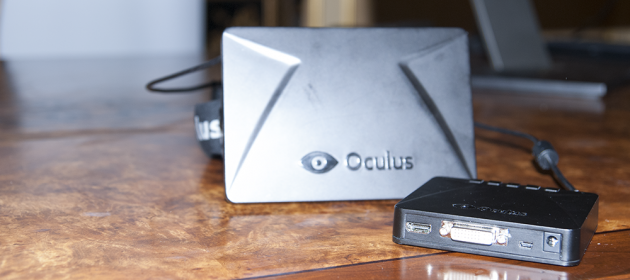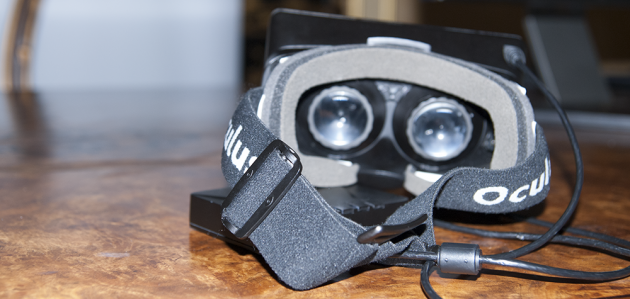At CES this year the folks behind the Oculus Rift had show space in a suite at the Venetian, where we got an hour to spend talking with the team and to experience the Rift first-hand.
For those who don’t know, the Oculus Rift is a stereoscopic 3D head-mounted display (HMD) that first gained widespread publicity when John Carmack used it at E3 2012 to demonstrate Doom 3 BFG Edition. A Kickstarter campaign seeking $250,000 was fully funded within four hours and ended up raising $2,437,429 by the time its September 1 deadline arrived. Since then, the buzz around this HMD has only grown, with high-profile endorsements coming from the likes of John Carmack (id Software) and Gabe Newell (Valve).
The demonstration setup used a developer kit which consists of a 5.6 inch 1280×800 display. Instead of the typical stereoscopic 3D, which uses active shutter glasses to alternate eyes between screen refreshes, the Oculus Rift divides the screen in half (640×800 per eye) and places a physical barrier between the eyes so each eye gets the full refresh rate. This has the advantage of eliminating the flicker and ghosting prevalent in current 3D implementations. Two lenses sit in front of the screen to aid the experience.
The demonstration system used an NVIDIA GeForce GTX 680 to guarantee a smooth experience. We were assured this was not a minimum requirement, and that lower-class GPUs would be able to handle gaming quite well, though 60 frames per second is the minimum needed to achieve a good experience with the Rift.
Going hands-on with the Oculus Rift
The headset was incredibly comfortable, especially considering I had the equivalent of a 5.6″ smartphone and a pair of Coke-bottle glasses strapped to my face. For just about everyone, there will be a brief period in which your eyes and inner ear will engage in combat—your eyes will perceive motion while your inner ear (which senses actual motion) will call bullshit. This is what causes motion sickness and if you’re prone, the Oculus Rift will not be your friend. In my case it took about 15 seconds for the initial disorientation to subside.
There is one word I absolutely despise in describing any kind of flat screen entertainment experience: immersive. In my mind it is impossible to have an immersive experience using a flat screen. 3D can’t do it. 4K can’t do it. And yet the Oculus Rift is, without exception, the most immersive gaming experience I have ever had. Bar none, end of story, etc. My moment of realization came when, during the demonstration, I audibly apologized to a virtual knight I had bumped into.
For the bespectacled, the current developer kit isn’t quite big enough for use with glasses. The final version, which uses a seven-inch display, should work well with most frames. During the demo I was able to see quite clearly without my glasses on, though I only require vision correction in one eye.
The challenge Oculus faces
Here’s where things get tricky though: for the Oculus Rift to be a successful peripheral, it will require widespread developer support and, possibly, standardization in a major software library (read: DirectX). It’s true that there are some very big players in the industry who support this particular project, which gives me hope for its success, but it will take a much larger amount of support to create a truly successful peripheral.
The second issue will be price. The developer kits run $300, and it’s not a stretch to assume the final product will cost about the same. That’s expensive for a peripheral, but perhaps not so much if it’s viewed as a 3D monitor (which is exactly what it is).
User adoption is the final hurdle. A piece of hardware can get all the developer support in the world, but if it doesn’t get purchased, that support is pointless. One only need look to the vast majority of PC and console add-on peripherals to see just what the Oculus Rift is up against. A $300 peripheral is asking a lot of potential customers and they’re going to want proof the Rift can deliver.
Why I think it’ll succeed
Developer kits should start shipping in late March or early April for Kickstarter contributors, and April-May for others. Based on some quick math from the Kickstarter page, there were 7,294 developer kits ordered as of the end of the campaign, not to mention the pre-orders directly from the Oculus VR web site (Oculus reps say around 10,000 kits have been ordered). I realize that not all of those kits are going to developers—there are undoubtedly a number of early adopters among that number—but a significant number of developer kits are going into the hands of some very creative people.
A growing number of games and game engines are planning support for the Oculus Rift. DOOM 3 BFG Edition works with the Rift right now. John Carmack has promised support for DOOM 4. Valve is looking to add support for its games (presumably by building support into the Source Engine and Source Engine 2). Both the Unreal and Unity Engines will gain support. Hawken has support right now. Minecraft is planning support.
There is enough support in the works right now to ensure the Oculus Rift won’t be an absolute flop. I suspect that the closer we get to a full commercial release, the more software support will start showing up. Hopefully Oculus VR will be able to bring the price down a bit—even a $50 reduction would go a long way to increase the user base as long as that lower price doesn’t include a sacrifice in quality.
I believe the Oculus Rift has what it takes to become a major success. How much do I believe it? My developer kit will arrive in a few months.
















 Articles RSS
Articles RSS